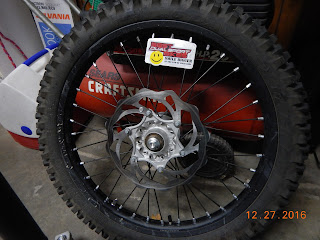Again another modification update for
my 2016 KTM 350 EXC-F Dual-Sport.
In my last several posts I described
several modifications I had completed to include:
1 3.45
gal (13L) fuel tank (KTM OEM)
2 Emissions
removal kit from KTMandHusky.com
3 Fuel
Rail from KTMandHusky.com
4 Wheel
Balance Weights from KTMandHusky.com
At
the end of that activity I mounted the fuel tank onto the bike, poured about a
half-gallon of fuel in the tank and immediately leaked out most of it from the
fittings on the bottom of the tank. The truth is that I expected this to
happen. While cleaning up the garage after installing the above mods I found a
rubber O-ring on the floor. It could only have come from the fuel tank mod as I
was installing the pump. I thought I had been very careful to ensure it all
went together as required but somehow the O-ring had dropped off the fitting
during my assembly.
Yesterday
and today I spent several hours installing the following modifications:
5 Grunt Mod from KTMandHusky.com
(exhaust port)
6 Snap Insert from KTMandHusky.com
(intake baffle)
7 Muffler End Cap from KTMandHusky.com
8 Repair leaking fuel tank
During
the fuel pump transfer from the original tank to the new tank I had noticed
that the fuel outlet fitting had an O-ring both on the inside and outside of
the tank but the other larger support plug only had an O-ring on the outside. I
assumed the O-ring found on the floor must be used on the support plug but on
the inside of the tank. I suspected it came off while removing the pump and had
fallen out of the old tank while moving it around. I looked through several
documents on the web trying to see a good parts break-down of this area but
didn’t find anything good enough to tell me if both plugs have double O-rings.
Therefore I expected to have to remove and replace the fuel pump again to
install the O-ring.
The
first three modifications went quickly and I then started the teardown of the
fuel tank to fix the leaking fitting. As I was removing the bottom two fittings
I quickly noticed that the O-ring was missing from the fuel fitting on the
outside of the tank! Fantastic, I didn’t have to remove the pump. Somehow the
O-ring had come off during my assembly of the fuel tank, just lucky that I
found it on the floor. I re-installed the O-ring and fittings, poured some gas
into the tank and found the fittings and line dry as a bone. I installed the
tank on the bike, temporarily connected the headlight module with the
key-ignition and tried to start the engine.
I
could hear the fuel pump prime the line and then tried the starter. It took
several tries but the engine finally fired up and ran exceptionally smooth. The
pipe sounded louder but not by much but it did have an exceptionally low meaty
sound! Can’t wait to get back to riding the KTM to see how all these mods
impact its performance.
During
the last few mods I went through all the areas I had been working and applied
locktight where required and torqued bolts. It is now ready for the upgraded
struts and rear shock due back in mid-January, just in time for cold weather to
come roaring through the mid-west.
Snap Insert
End Cap
Leg-3 Initial Plans:
I’ve completed the planning for Leg-3
and have received commitments from one other rider (my son Jeff) and a new
support truck driver (Michael). BTW I’m Mike and he’s Michael in all follow-on
posts. The remaining three core TAT riders are pretty sure they will be going
and will commit in the near future; Woodrow, Terry and Steve. We may even pick
up a couple more friends and family members but as we found on Leg-2 (CO-AR), a
smaller group works better than a large herd of riders.
The key points of Leg-3 are listed
below but I will provide more detail in future posts:
Dates: mid
July 2017
Ride days: 6 (Monday
through Saturday)
Total trip days including shuttle of
bikes 15 days
Departure Point: Lake
City, CO
End Point: Ketchum, ID
TAT miles: 1171
We have modified the TAT route in one
area and I’m sure this will generate comments. As we come up to the Interstate
Highway to Salt Lake City we are heading North on back roads and reconnect with
the TAT just North of the Great Salt Lake. This reduces the route by about 150
miles but mainly it eliminates the long desert run to Nevada, north along the
Nevada/Utah border then return to Salt Lake. I’m sure there are many scenic
sites along that stretch but it also has many miles of nothing but desert. Our
TAT adventure is a coast-to-coast ride on Dual-sports, not a 100% ride of every
mile of the TAT even though we will use more than 90% of the TAT route. Our
team has time constraints and we want to complete the whole adventure NLT 2018.
If we do Leg-3 in 2017 it will leave about 1200 miles for Leg-4 (ID to OR) in
2018.
Leg-3 Route
Happy New Year!













































